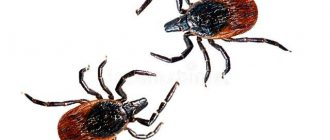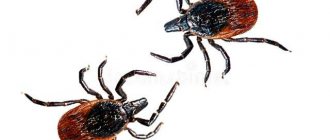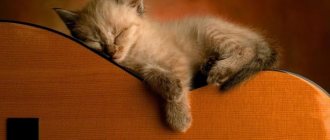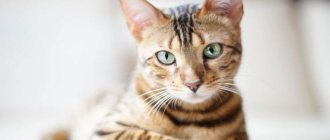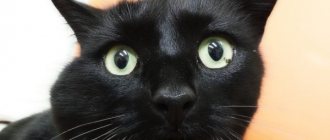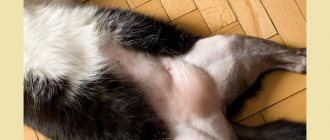Cats have a flexible fold of scruff on the back of their heads, which has a special structure, and doctors use it to treat animals. This withers in a cat is located in the place where the cervical region meets the spine. During illness, doctors inject precisely into this area. It is important for the pet owner to know about it; you need to take the animal by this fold carefully and in special cases.
What is the withers and where is it located?
The withers are located on the back of the animal's head in front of the shoulder blades, which are not difficult to feel with your hand. The body in this area is arched, since the first 5 cervical vertebrae are located under the skin and fat layer. With the help of muscles and tendons, the neck is connected to the body, so this fold is elastic and can be easily separated from the muscle tissue. Thanks to these structural features, namely flexibility, cats perform complex jumps; height is not an obstacle. Despite the fact that the scruff of the neck has a thick layer, there are few nerve endings in it, this is the best place for injections.
Advantage of drops
Until recently, fleas could only be removed from a cat using various types of shampoos. Today, pet stores sell all kinds of sprays against parasites, as well as drops in capsules. When using the latter, the medicine is usually applied precisely to the withers of the animal. This method guarantees that the cat will not lick the drug, get it with its paw and get poisoned. It’s clear where the cat’s withers are. Essentially, this is the highest point of the back. Therefore, after application, the medicine is distributed relatively evenly by gravity over the animal’s back and sides, which ensures the best effect. Of course, for the drug to be as effective as possible, it must be used correctly.
Why is it needed?
By nature, the withers have the ability to paralyze the motor activity of the animal when exposed to it. This occurs when receptors inside the fold work; they send impulses to the brain, activating the function of stopping movement. This ability allows the animal to freeze at the right moment, while the pet has the ability to carry offspring without creating noise.
In kittens, there is a section in the cerebellum that is responsible for balance in the air. When they are taken by the scruff of the neck, the brain receives a signal from the cerebellum that it needs to behave calmly and assume a fetal position. Therefore, the cubs are not hurt, they calmly react to such manipulations.
During the training process, in order to convey information to the animal, you need to grab the withers and slightly press the pet to the floor.
The scruff helps owners in matters of raising tailed animals; she is responsible for their behavior. With the correct influence on the fold, it is possible to carry out educational actions on a pet. If the pet does not obey, misbehaves, or shows aggression, the owner must firmly grasp the withers and slightly press the cat to the floor. In this case, it is necessary to quietly but confidently tell the animal that this cannot be done. The main thing to remember is that adult cats should not be lifted by the scruff of the neck; it may hurt them.
How to influence a naughty pet using his own scruff?
Reflexes associated with the withers persist in cats throughout their lives. You cannot lift pets weighing 3–5 kg or more by the scruff of the neck, but you can use their natural instincts for educational purposes and in the training process.
The effect on the withers receptors allows you to control the behavior of even the most wayward and obstinate animals that show aggression towards humans.
By properly grabbing the scruff of the neck, you can prevent fights between cats, and also stop your pet from crapping in the wrong places or sharpening its claws on upholstered furniture. Experts consider such actions more effective than punishment. To re-educate your pet, you need to apply the following algorithm:
Firmly but gently grab the cat by the fold of skin on its neck
It is important to control your grip strength. The animal should not feel pain
We need to make him understand that he is not the strongest and the person in this house is the main one. Holding the scruff of the neck will force the pet to obey. Press the aggressor to the floor, continuing to hold him by the scruff of the neck. Say the prohibition word: “no”, “impossible”. You must speak clearly, firmly, but calmly, without raising your voice. Screaming in this case is unacceptable. It’s better to copy the behavior of a disgruntled cat and hiss at your pet. This signal has been familiar to him since childhood. This is how the mother made it clear to the baby that she did not like his behavior. Hold the cat until he relaxes. You can speak to him in a calm tone to help him calm down. Typically, pets need no more than 5 minutes to realize their guilt. Release after complete relaxation, praise, caress, removing your hand from the withers. For obedience, you can treat the obedient animal with a treat.
For some animals, one educational act is not enough to improve. In this case, the actions must be repeated if a similar situation arises. As a result of several repetitions, the pet will understand what the owner does not like.
Why are medications applied to the withers?
The back of the head is used to treat a pet; it is suitable for subcutaneous injections. Injections into this area are more effective; the drug is absorbed into the blood faster due to the elasticity of the fold. The animal does not experience severe pain during medical procedures. The scruff is used in the fight against fleas and helminths in pets, but it is not available for licking off the medicine. Special anti-parasite drops are placed on the back of the head. There is no need to bathe the kitten after applying the drug; touching or stroking this area is contraindicated - the applied drug can cause poisoning.
Application rules:
- Wear gloves.
- Grasp the withers and spread the fur.
- Apply the medicine to the cartilage protrusion.
- Grind the preparation so that it does not spread.
Preparing for treatment
Thus, now the reader knows where the cat’s withers are.
How to find it if you need to use medicine is a simple question. However, when using the drops themselves, several important rules should be followed. Firstly, the cat should not be bathed for 2-3 days before using the medicine and for 2-3 days after that. Secondly, before using the drops, the animal’s withers must be carefully examined. If there are large lesions and wounds on it, it is better not to use the medicine. If the circumstances are unfortunate, the insecticide may enter the animal's bloodstream, which will lead to poisoning. When performing the procedure for applying the drug, the cat should be gently held behind its back with your left hand. You should not administer medicine to an animal that is worried about something, has become playful or is angry. The cat may jerk during the procedure to escape, and the drops will fall too low on the body. As a result, the animal will subsequently be able to reach them. Wait until your pet calms down.
Diseases, injuries and treatment
The pet can injure the withers at the time of mating. In such a situation, you need to treat it with brilliant green or peroxide, then trim the hair around the damage and apply a bandage. The fold is a significant area of the body; if it is inflamed, swollen, or red, you should immediately contact a veterinarian. You should not inject antibiotics yourself; only the doctor knows which ones and how hard the syringe is injected under the skin. Next to the scruff is the neck. You can injure the back of the head if you lift or drag the cat by the withers, as children do. Damage to the cervical spine can lead to serious health problems for the animal and even death. It is necessary to take it by the fold carefully.
What is the withers used for?
The owner can use the features of the withers when raising and caring for his pet.
Impact on the withers during training and education
Any cat owner should know how pressure on the withers affects their pet. If possible, this knowledge can be used for training or raising a pet, as well as suppressing aggression. As an example, we can take the development of the necessary reflexes. If the pet has performed some unnecessary action (sharpening its claws on the sofa or making a puddle in the wrong place), the following algorithm is used:
- Carefully, quite firmly, take the cat by the withers. With this gesture, the owner makes it clear that he is a strong leader. This must be done for the animal to show obedience.
- Lightly press the animal to the floor. At this time, firmly and clearly, without raising your voice, pronounce the word “impossible” or “bad.” Many owners begin to hiss instead of words, following the example of angry cats. By this, the owner brings his pet to the understanding that he is dissatisfied with his behavior or trick.
- Keep the cat in this position until the animal’s muscles begin to relax. As soon as the pet becomes soft and pliable, it can be released.
- Next, you need to praise your pet or treat it with a treat.
Do not forget that the educational moment should not cause pain in the animal (holding the withers itself does not bring discomfort).
The same method of education can be used if the cat shows aggression. From the outside it looks strange, but the method really helps. It only takes 3-5 minutes to hold the cat by the withers, and after the second or third time the animal begins to understand why its owner is dissatisfied.
Even for training purposes, you should not grab a cat by the scruff of the neck and lift it high, much less shake it in this position. This can cause injury to the animal, which will result in significant health problems.
How to use the withers to treat a cat
Veterinarians carry out various procedures; the animal’s withers become the location of many of them.
Application of medications
A striking example of the use of the withers for medicinal purposes is such a moment as ridding an animal of fleas. For this, special drops are used. The place where they are applied to the withers is determined by the fact that the cat cannot reach here with its tongue or paw, which means it will also not be able to lick off the medicine.
Some medications are applied to the cat's withers, because from here she will not be able to lick them off
Injections
The withers are used for subcutaneous injections. These could be medications for a sick animal or vitamins. The choice of location is determined by the following circumstances:
- An injection under the skin at the withers does not cause pain, since this is an area of low sensitivity.
- The drug injected into the withers penetrates the bloodstream faster, since subcutaneous fat has a loose structure and high absorbency.
If possible, the injection into the withers should be carried out with an assistant who will hold the animal.
The withers are used as a site for subcutaneous injections
At the moment of injection, the needle should not go deeper than a third. This rule must be observed, since violation can harm the cat. If the owner is not confident in his ability to give injections, then you can use an insulin syringe, which has a small and thin needle. If this option is not suitable, then it would be useful to contact a specialist. You should not experiment with your pet's health.
Video: how to give a cat an injection at the withers
comments
Vitaly I train according to your recommendations: stand, sit, front. Alexey I do not agree with the opinion that modern pets are stupid animals to which only the most basic version of training can be applied. Kysa is fully aware of what the withers are, how it affects her, and has a personal opinion on various facts and stimuli. For example, cats that have experienced serious trauma and were treated by a veterinarian are treated much better
Perhaps the most important thing is consistency, completeness and extremely equal treatment - as much as you think possible. Believe me, the majority of people are not much superior to the thinking capabilities of cats - they just don’t have a developed language or writing, so their brain is developed “in the other direction” - for example, they understand non-verbal signals an order of magnitude better than people
Natalya Delnaya become. She herself used the withers of her cats for the purpose of raising them. At one time, when I adopted my first cat, in order to understand its character, I stocked up on books on animal psychology. And from there I learned that in order to be able to become an authority for a cat, you need to become the eldest cat in the pride
This is very important, then the cat will respect and trust the owner. That's how I built relationships
But then I came across a seasoned street cat who somehow survived the injury. The cat was already at least a year old, he had ear mites and established street habits, and he was also a real big fighting cat. I suffered with him for almost a year. Our wars were serious, he did dirty tricks and at the same time he brazenly looked into my eyes. This is where the withers came in handy. It was thanks to the fact that I began to grab him by the withers and press him to the floor that I did not receive scratches from his huge claws, and I made it clear who was boss in the house. And the cat obeyed. We have been living in perfect harmony for 8 years now.
Precautionary measures
Flea drops, like other specialized medications, are not toxic to your pet
Despite this, when using them, precautions must be taken so as not to harm the animal. These include:
- Before using the drops, inspect the skin where they are applied. If there are open wounds, scratches or other damage on it, then the drug cannot be applied;
- It is forbidden to handle kittens that feed on their mother's milk. The cat constantly licks her babies. At the same time, she will definitely lick off the drops applied to them. This may provoke negative consequences for her health;
- The kitten is allowed to use only specialized medications. Products for adults are not recommended for use;
- The drops used should not get on the cat's nose, eyes or mouth. If this happens, they should be washed off immediately with plenty of running water. After this, it is best to show the animal to a veterinarian;
- In some cases, drugs can cause an allergic reaction. If this happens, consult your veterinarian;
- Be careful not to lick the product off, especially if it is applied in multiple places along the spine. If this happens, observe your pet's behavior. At the first symptoms of poisoning, seek help from a specialist.
Compliance with such precautions will allow you not to worry about the health of the animal during treatment. Don't neglect them
Basic recommendations
Flea drops for cats are an effective and safe remedy that will quickly get rid of parasites. Today, such drugs are manufactured by various companies. When choosing, you should focus on the age and weight of your pet. Not all products are suitable for kittens and pregnant females. When using such drugs, the following recommendations must be observed:
Before applying the product, carefully read the instructions. It tells you how many drops you will need and where it is best to drop them. Most often, it is enough to apply a couple of drops to the withers. Some products are recommended to be dripped at three points along the spine; Cat drops may not be effective if your cat gets wet after using them. Therefore, for several days after treatment, do not bathe the animal or let it go outside in rainy weather; Drops can also be used for preventive purposes.
This is especially important if the cat is walking outside. In this case, it is sufficient to carry out the treatment once every six months; The product can only be applied to dry skin; Before using such products, it is better to consult a veterinarian, as they have some contraindications.
Following these recommendations will make the use of drops safe. The main thing is to start treatment as early as possible. Remember that a cat suffers greatly from a flea bite.
Interesting fact
Where the withers are located in cats, and what injuries the pet most often receives in the scruff area is therefore clear. As you can see, this place is significant for the animal’s body. Among other things, the withers also have one very interesting property. The fact that kittens calm down immediately after a cat takes them by the scruff of the neck, hang calmly and do not try to escape is well known. Why is this happening? Why do kittens hang in their mother’s teeth like lifeless “bags” in the fetal position? In fact, this behavior is primarily due to the presence of a special zone in the cat’s brain. As soon as the animal is taken by the scruff of the neck, certain impulses begin to flow from here, calming it. At the same time, the cerebellum gives the cat a signal to take a characteristic pose.
Scientists believe that such a mechanism was developed in these animals during the process of evolution. After all, a cat will not simply transfer its offspring from place to place. She acts in this way only when her children are in any danger. A screaming, attention-grabbing kitten in nature simply has a significantly reduced chance of survival.
Injuries in the withers area
Most often, such damage occurs in animals during mating. A cat rarely leaves wounds on a cat’s withers, but sometimes this does happen. To treat the area around the lesion, you first need to trim the fur. Next, you should rinse the wound with hydrogen peroxide. You can also use Terramycin spray or brilliant green.
Old wounds with signs of inflammation should be treated with antibiotics. This could be, for example, Misofenom ointment. It is applied to a napkin and applied to the wound. Then a bandage is applied. But, of course, it’s better not to let things get to the point of inflammation. If the damaged area is swollen and red, or there is pus coming out of it, you should immediately contact a specialist.
Application of medications
An example of the use of cat scruff for veterinary purposes is the application of drops against skin parasites such as fleas or ticks. For this purpose, medicinal products are used that affect pests. Experts choose this particular area because the animal is not able to reach it with its tongue or paw. It will not be able to lick off the drug before it is absorbed.
The scruff of the neck is the first place on a cat’s body where medications are injected.
The scruff is also used when administering subcutaneous injections, which include medications or various vitamins to improve the pet's immunity. The choice of this area is explained by several factors:
- the scruff of the neck has the smallest number of nerve endings, so injections are completely painless;
- The fat layer present at the withers is distinguished by its loose structure and ability to quickly absorb medications, distributing them throughout the animal’s body.
Important! When injecting at home, it is advisable to select an insulin syringe, since it has a fairly short needle that is not able to penetrate more than 1/3, thereby without injuring the cat.
How to recognize a cat's breed by external differences
Studying the appearance features will help determine the cat's breed .
Ears
The shape of the ears is a striking distinctive feature indicating belonging to a particular breed.:
- forward-curved ears are characteristic of the Scottish Fold and Highland Fold;
- turned back - only in the American Curl;
- small, low-set, close to the head - in the Highland Fold;
- medium-sized ears, devoid of vegetation with drooping tips - in the Ukrainian Levkoy;
- large, wide at the base, open, with smoothly curving tips - in the elf;
- triangular, pointed, with tassels at the tips - in the Maine Coon;
- hanging ears covered with curls of hair - the poodlecat;
- disproportionately large in relation to the head - in Abyssinians and Orientals.
Short tail
A short tail is a congenital trait that defines the breed:
- American and Kurilian bobtail;
- pixie bob;
- toy bob;
- Kymrik.
Toy Bob
Tailless breeds - Japanese Bobtail and Manx cat.
Reference. Cats of the eastern group of breeds have long and thin tails.
Little paws
In nature, short-legged cats are rare.
All breeds with short limbs were bred artificially:
- bambino;
- Dwelf;
- munchkin;
- minskin;
- Napoleon;
- skookum.
How to inject into the withers correctly
It is best to inject medicine into an animal with an assistant. This procedure is carried out as follows:
- The cat is placed on its side on the table with its back to itself. The assistant must hold the animal by the hind legs and back.
- With the left hand, the skin on the withers is pulled back with a fold.
- The injection is made by pointing the needle parallel to the back.
If there is no assistant, you don’t have to place the cat on its side. In this case, it will be more convenient to place it on the floor or on the sofa. The injection is given to the animal by pressing it with the elbow of the left hand and at the same time pulling the skin with the fingers. Finding where the cat's withers are will also be easy in this case. The injection itself is done by inserting the needle no more than a third. Only a children's or insulin syringe can be used for injection.
How to recognize a parasite infestation?
It is important to start treatment as early as possible. Fleas, ticks and other insects can cause suffering and harm to your cat's health. Infection is especially dangerous for kittens, since their bodies are still weak and quickly depleted. You can determine that a cat is infected with parasites by the following signs:
- A cat may suddenly fall and bite itself in the tail area - this is a sure sign of flea infestation;
- If a pet scratches its sides, then its back, then its paws, most likely it is tormented by fleas;
- Spread the six parts of the animal in the back area and carefully inspect the skin. If it is affected by blood-sucking insects, red dots, irritation, and spots will be visible on it. If the infestation is too strong, then with such an inspection it will be possible to detect the insects themselves. Traces of their vital activity are often found, for example, grains of blood or parasite eggs.
Monitor your pet's condition carefully. If you notice any suspicious symptoms, conduct a thorough examination.
How to find out a cat's breed by coat color
Aristocratic cats compare favorably with ordinary yard cats by their variety of colors . For the latter, it is often simple - tricolor, spotted and striped, one- and two-color.
Breeders worked on the color of purebred cats, achieving interesting colors.
Siamese
The Siamese color or color point is one of the most beautiful and spectacular . It is characterized by dark areas on the animal's face, paws, ears and tail. The body is light in color.
Initially, only Thai and Siamese cats had this color, but as a result of breeding work, the following breeds acquired the Siamese color :
- Balinese;
- Burma;
- Himalayan;
- Neva Masquerade;
- Persian;
- ragdoll;
- snowshoe.
There are several variants of point colors:
- blue point - silver-blue;
- caramel point - gray-beige;
- cream point - beige-amber;
- lilac point - pink-blue;
- red point - rich apricot;
- seal point - delicate cream;
- fan point - pale cream;
- cinnamon point - reddish brown;
- chocolate point - brown chocolate.
Only a specialist can identify point colors . Kittens are born white and the markings appear after a few days.
Blue
The blue color is the same as solid gray, an integral characteristic of the British Shorthair cat . The color is determined immediately at the birth of the babies.
Shades of gray are found in these breeds:
- korat;
- Maine Coon;
- Nibelung;
- oriental;
- Russian blue;
- chartreuse;
- Scottish.
Sand
Sand color or sorel is the least common color and defines the breeds - Abyssinian and Somali cats . The fur is unevenly colored: the main part is bright red (copper), and the tip is ticked (dark, chocolate brown).
Abyssinian cat
Wild
Wild natural color or tabby is characterized by the presence of clear spots, stripes, rosettes , making domestic cats small copies of leopards and cheetahs. This color is observed in the Bengal, Egyptian Mau, Siberian cat, Asherah, Safari, Serengeti, Kurilian bobtail, Ocicat, Caracat, Kanaani. The color is characteristic of hybrid breeds and is determined instantly.
Mackerel tabby color
Brown
Brown or chocolate uniform, monochromatic coat color is typical for cats of royal origin and is almost never found in the wild.
The breeds can boast of this color:
- Abyssinian;
- British;
- Burmese;
- Havana Brown;
- Persian;
- Chantilly Tiffany;
- Scottish.
Injections for cats
The withers are also used to give injections to sick cats. After all, subcutaneous injections are less painful than intramuscular injections. In addition, the medicine injected under the skin is absorbed into the blood faster. The skin in the withers area is more elastic than in other places, so the pain will be less. Also, when exposed to this area of the body, the animal shows obedience, which is why injections are given to cats in the area of the withers.
It is best to give the injection not alone, but with a person who will help put the cat down. The pet should be placed on its side, with its back to the person injecting. Grabbing the cat by the withers, insert the needle parallel to the back. In this case, you need to pull the skin of the withers up a little so that the reflex works and the pet calms down.
If one person will give the injection, then it will be better to sit the cat on a flat surface and let the cat take a horizontal position, pulling the skin with his left hand, give him an injection, as shown in the photo. The needle must be inserted exactly a third of the way - no more can be inserted, as this can be dangerous for the animal. In this case, only a small syringe is used, but an insulin syringe is allowed.
How to recognize a cat's breed by its special coat
The structure of the coat varies greatly among different breeds . Cats are mostly divided into short-haired and long-haired.
Long, thick and straight coat with dense undercoat:
- Angoras;
- Burmese;
- British and Scottish longhair;
- Himalayan;
- Maine Coon;
- Neva Masquerade;
- Norwegian forest;
- Persian;
- ragdoll;
- Siberian;
- Somalia;
- Turkish van.
The Bohemian Rex, Selkirk Rex, Laperm have long and wavy fur
Short with tight curls in the Cornish Rex, Devon Rex and German Rex.
a coarse and curly coat .
Bald breeds:
- bambino;
- Dwelf;
- Don and Canadian sphinxes;
- kohanu;
- minskin;
- Peterbald;
- Ukrainian Levkoy;
- elf.
Reference. Rex cats have pleasant and soft fur, reminiscent of astrakhan fur.
Sphinx
Physiology
To understand whether or not you can pick up a cat by the scruff of the neck, you need to understand their physiology. Mother cats often carry their kittens by the scruff of the neck. Small, at this moment they resemble a funny fluffy toy, and not a real animal. But a person is not a mother cat. People think that if a cat can do it, then so can they, but this is not true. Firstly, the cat does this very carefully and not often. Secondly, she is carrying a small kitten, not an adult animal.
Kittens have softer, more elastic, pliable skin and muscles that have not yet fully developed. That is why the kitten does not hurt when it is carried. But as a cat grows, its skin becomes less elastic and rougher. The weight of the animal increases and therefore it is often impossible to pick up an already adult cat by the scruff of the neck.
- This is a lot of stress on the skin, which can stretch too much if this is done from an early age of the animal. In some cases of particularly clumsy lifting, tears may appear in the skin.
- The muscles of an adult cat are already well formed. The animal may begin to wriggle out and cause harm to itself. But even if the cat does not wriggle out, such an action can pull his neck muscles.
- Due to the significant weight of the cat, the skin can press on his throat, and he will begin to choke. And this will lead to panic in the animal and aggressive actions. This happens rarely, but it is also possible.
- In rare cases, if you sharply pull a cat by the scruff of the neck, it is possible that the spine may be damaged.
